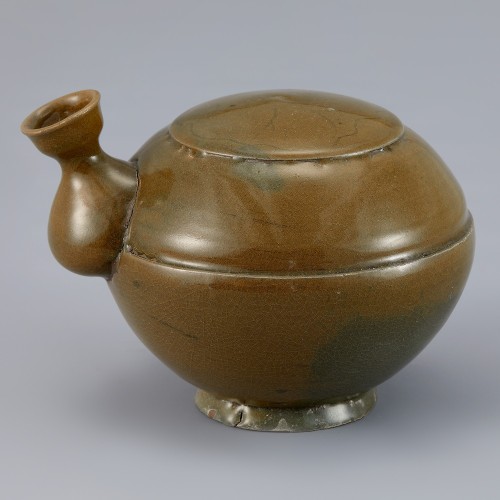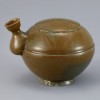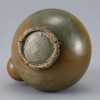본문
이 유물은 고려시대에 제작된 휴대용 청자 자라병으로, 실용성과 상징성이 조화를 이루는 독창적인 기형의 청자입니다.
자라병의 형태는 장수와 생명력을 상징합니다. 삼국시대 토기에서 그 기원을 찾을 수 있으며 고려시대에는 청자라는 고급 재질로 승화되어 불교 의식기나 휴대용 기물로 발전하였습니다.
몸체는 위아래를 따로 성형하여 접합하였으며, 윗면에는 뚜껑을 만들려다 고정된 듯한 모습이 남아 있습니다. 이 윗면에는 정교한 음각의 연잎 문양이 새겨져 있는데, 이는 불교에서 청정, 해탈, 생명을 상징하는 연꽃의 의미를 담고 있습니다.
특히 일반적인 자라병에서 보이는 수구 형태와 달리 이 자라병은 정병에서 볼 수 있는 길게 솟은 수구를 지녀 주목됩니다. 병 몸체 상단에 붙어 위로 곧게 솟은 관 모양을 하고 있으며 액체를 따르기 좋게 설계되어, 실용성과 조형성이 함께 강조된 형태입니다. 이런 특수한 수구의 형태와 연꽃 문양은 이 자라병이 불구(佛具)로 사용되었을 가능성을 시사합니다.
표면에는 유약 아래 자연스럽게 퍼진 미세한 균열문이 나타나며, 이는 고려 청자 특유의 깊이 있는 색감과 은은한 조형미를 더욱 돋보이게 합니다. 녹갈색 유약은 철분 함량이 높은 태토를 고온에서 소성하여 얻어진 것으로, 고려 청자의 대표적인 특징 중 하나입니다. 또한 굽 바닥에 남은 백색 내화토의 흔적은 당시의 제작 기술을 엿볼 수 있습니다.
이 자라병은 고려 청자의 뛰어난 조형성과 정신성을 함께 지닌 예로, 아름다움과 기능성, 상징성을 고루 갖춘 귀중한 유물로 사료됩니다.
━━━━━
此文物为高丽时代制作的便携式青瓷器,以乌龟造型展现了实用性与象征性的和谐统一,造型独特,别具匠心。
乌龟瓶的形态象征长寿与生命力,起源可追溯至朝鲜三国时代的陶器,高丽时期则以高级材料青瓷将其升华,常用作佛教仪式用器或便携器皿。
器身分上下两部分分别成型后粘合而成,顶部原欲设盖,最终似为固定而保留其形状。瓶背雕刻精细的阴刻莲叶纹,莲花在佛教中象征清净、解脱与生命,寓意深远。
尤为引人注目的是其瓶口造型,区别于一般乌龟瓶,此件作品采用净瓶式上扬长颈口,便于倒取液体,兼具实用性与造型美感。这一特别设计与莲花纹饰结合,显示其可能曾作为佛具使用。
瓶体釉面下自然生成细腻开片,凸显高丽青瓷特有的深邃色感与淡雅之美。釉色呈青绿中泛褐,由高温烧制含铁胎土而成,是高丽青瓷的代表性特征。底部可见残留白色耐火黏土痕迹,亦反映出当时的制作工艺。
此乌龟瓶不仅展现高丽青瓷卓越的造型艺术与精神内涵,更兼具美观、功能与象征意义,堪称高丽青瓷中的珍贵文物。
━━━━━
This is a portable celadon turtle-shaped bottle made during the Goryeo Dynasty, representing a unique form that harmonizes practicality and symbolism.
The shape of the turtle bottle symbolizes longevity and vitality. Its origin can be traced to turtle-shaped earthenware of the Three Kingdoms period, which evolved during the Goryeo era into high-quality celadon vessels used in Buddhist rituals or as portable containers.
The body was molded in two separate parts—top and bottom—and then joined together. The top surface features what appears to be a lid that was intended but then fixed in place. This surface is adorned with finely incised lotus leaf patterns, representing purity, enlightenment, and life in Buddhist symbolism.
Notably, unlike the spout structure commonly seen in turtle-shaped bottles, this example has a tall, upright spout resembling that of a ritual ewer, which draws particular attention. The spout rises straight up from the top of the vessel, allowing for easy pouring and emphasizing both functionality and sculptural beauty. This distinctive spout and the lotus decoration suggest that this bottle may have been used as a Buddhist ritual object.
Under the glaze, delicate crackle patterns have formed naturally, highlighting the deep color and subtle beauty characteristic of Goryeo celadon. The greenish-brown glaze was achieved by firing iron-rich clay at high temperatures—one of the hallmark traits of Goryeo celadon. Traces of white refractory clay left on the foot offer a glimpse into the ceramic techniques of the period.
This turtle-shaped bottle exemplifies both the refined artistry and the spiritual essence of Goryeo celadon, making it a valuable cultural asset that combines beauty, utility, and symbolic meaning.



